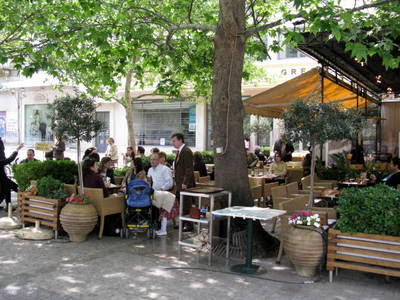What a different reaction I had today! It was cool, clean, and not congested. Why the difference? Well, it is April—the very best month to visit the Mediterranean, in my opinion. It is Sunday—no congestion. The recent Olympics—they spent billions to build new transportation systems, clean buildings and monuments, and build sports venues. This is the Peace and Friendship Stadium.
We are docked at the Port of Piraeus which is really three ports in one: for ferry boats, for commercial shipping, and cruise shipping.
This is the commercial port with semi-trucks that have just driven off large commercial ferries. Note the buildings in the background which are painted with historical scenes.
Instead of taking a bus panoramic tour of the city, I chose a walking tour through the Ancient Agora and the Plaka. What a superb choice! We were a small group, and we had a great guide.
The Ancient Agora (from the verb “ageiro”, meaning to gather together) was absolutely essential in the organization and functioning of ancient Greek cities. It was the political and administrative center of the city-state, and it was the place where social, commercial, and religious activities concentrated. Once in this place, Socrates, Aristotle and others would gather to teach and talk. It was here that democracy evolved.
On the other hand, the Acropolis (“acro-“ meaning high as in acrobat, acrophobia, and –polis meaning city) is where people felt closer to their gods. This is looking up the north view of the Acropolis from the Agora.
People lived in the Ancient Agora area until 1931 when John D. Rockefeller paid to have the area excavated and preserved as an historical place. The people who had lived here generation after generation used the building materials from earlier times to build and rebuild their own structures, so there isn’t much left of the original.
This Athenian Dog is surveying the remains.
The Temple of Hephasestus (God of Fire), on the other hand, is one of the best preserved monuments in Athens. It has withstood wars, earthquakes, and humans since it was on a high hill and not in the basin of the Agora. It was later used as a Byzantine Church named after St. George.
The Stoa of Attilus II has been reconstructed to show what some of these buildings once looked like. This was a shopping center with stores lining the long, covered walk way. Today it is a museum.
Right next to the Ancient Agora, is the modern day shopping area called Plaka. On Sundays, flea markets abound, people gather to have their coffee and talk, and tourists ride a little red train to gawk at it all.
We meandered through the Plaka passing what I would call “cheaper shops” like these where the merchants were standing outside waiting for customers…
Continuing through streets that had more expensive shops where their merchants sat in chairs almost in the middle of the tree-shaded street in front of their shops.
We then stopped in this café for mezedes (Greek appetizers).
Mezedes usually include tomatoes, cucumber, olives, grape leaves, feta cheese, bread, and ouzo or wine.
After our mezedes, we had some "free" time in which I spent some $$$ on a "souuvenir" for me which I bought here. The name of the shop is Georges. That name has followed me everywhere this trip.
This was a very relaxed and memorable Sunday morning.















No comments:
Post a Comment